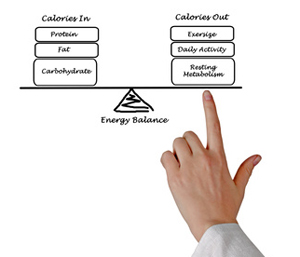Eating the same number of calories every day – in a deficit – is the simplest and most common approach for setting up a fat loss program. But did you ever consider that you could intentionally consume different amounts of calories on different days, shift the way that you monitor your calorie deficit, and that might make it easier to follow your diet and make you a happier eater? It’s true. Read on and find out why…
 Many dieters have become more successful (and happy) because they shifted the way they were looking at their calorie intake from only daily tracking to weekly tracking as well.
Many dieters have become more successful (and happy) because they shifted the way they were looking at their calorie intake from only daily tracking to weekly tracking as well.
Why? Because it gives you a new and different perspective.
That bigger picture (7-day) view gives you more flexibility to enjoy your meals, and eat more food at specific times when you want more.
And, as everyone who keeps up with the latest in techniques for effective (and lasting) fat loss knows, flexible dieting is in and restrictive dieting is out.
An example of looking at calorie deficits weekly
Lets assume your daily maintenance calorie level is around 2000 (typical for a lightly active female). That’s 14,000 calories you burn over the week (2000 per day X 7 days).
Suppose you want to lose fat, so you set a deficit target for fat loss at 1500 calories per day. That’s 10,500 calories over the week (1500 per day X 7 days). Focusing on that daily deficit, every day, has always been the traditional way of doing things.
14,000 minus 10,500 is a 3,500 calorie deficit for the week. So at the end of the week, if you hit your 1500 calories per day goal, your 3,500 calorie weekly deficit should, on paper anyway, result in a pound of weight loss.
But for a variety of reasons, including travel, social events and personal preferences, it may not be practical or desirable to eat precisely 1500 calories per day, every day. Some days you might want to eat less and some days you might want to eat more.
If you stop worrying about hitting one specific deficit every day and instead look at weekly deficits too, you realize you can! You don’t have to eat in a calorie deficit 7 days a week to lose fat every week.
What if your week looked like this:
Calories shifted – Example A:
Monday 1250
Tuesday 1500
Wednesday 1500
Thursday 1500
Friday 1500
Saturday 2000
Sunday 1250
On this weekly calorie plan, you don’t eat the same amount every day, but if you add this all up for the week, its the same 10,500 calories right? And so you still have a 3500 calorie deficit for the week, right?
Will this calorie shifting (or “cycling”) have any special effect that increases your fat loss beyond more linear dieting? Probably not. Will it have the same positive result (fat loss) as eating 1500 a day, every day? Yes, it probably will, because the maintenance level calories on Saturday are offset by the larger deficit on Sunday and Monday.
This can be set up on purpose, but some days calorie fluctuations happen by accident too, and understanding weekly deficits lets you relax, knowing that one day doesn’t ruin a whole week, as long as you adjust and stay focused on that weekly big picture.
In other words, it’s the weekly deficit that matters, not what happens at one meal or on one day. A 2000 calorie Saturday – even with a 1000 calorie meal – would not be a mistake and wouldn’t set you back at all. But the extra 500 calories at one particular time, such as a holiday feast or an evening dining out with friends, may have made you a happy camper.
If you want to lose a pound of fat, you’re simply aiming for a 3500 calorie weekly deficit – those are the rules you can’t break. The rules about how you distribute those calories are a lot less rigid than most people think. The example above is only one of many possible arrangements.
What are the pros and cons of this approach?
An advantage of eating the same thing and the same amount every day is simplicity. Fewer moving parts means less to think about and easier to follow. But if you have higher and lower days pre-planned and lower calorie days don’t bother you, then any downsides of cycling calories are minimal.
A potential pitfall to avoid is cutting calories extremely low on deficit days. This can increase the risk of getting really hungry and it may trigger unplanned eating, bingeing or going way beyond your intended calorie target on the high day.
There’s a reasonable balance that must be pursed, and calorie extremes in either direction are best avoided.
Another thing you want to avoid most of the time is using this kind of calorie shifting during the week as a damage control strategy after an unplanned caloric excess. Here’s why:
I believe then you run the risk of getting trapped in a potentially unhealthy binge-starve behavior cycle where the low calorie days are like punishment, and they come along with guilt (often accompanied with extra exercise, also as punishment). You want to avoid that kind of behavior and mentality, because it is not fun.
Occasionally you need to tweak and adjust your week’s nutrition on the fly. But wouldn’t it be better to plan ahead and build in a higher calorie day to enjoy eating more at times without guilt? This is also helpful for holidays, birthdays, social events or weekend restaurant outings that people on fat loss diets often dread, but shouldn’t have to.
If your plan was 1500 calories a day, every day, but you have 2000 or 2500 calories in one day, you tell yourself you messed up. But if you follow a plan you created in advance that includes a 2000 calorie day, or even a 2500 calorie day, eating those extra calories is not “cheating” – it’s part of following your weekly plan.
Also remember, if you know you’re allowed higher calorie days from time to time and it won’t diminish your results, you’ll be less likely to binge in the first place. You’ll find it easier to stick with your deficit days because you know that a higher calorie day is always right around the corner.
Is this the same as carb cycling?
Carb cycling is a technique made popular by bodybuilders where you’re not in a calorie deficit every day; instead you take one or two high calorie days per week. This is done for a variety of reasons including:
1. Enjoy social occasions and dining out more
2. Get some relief from low calories all week long (makes it easier to stick with a diet)
3. Give your metabolism a brief boost
4. Boost energy
5. Improve retention of lean body mass (or increase chances of recomposition)
Extremely lean bodybuilders or physique athletes might take two high calorie days per week, but for most people, a carb cycling weekly meal plan for fat loss might look something like this*
Calories Shifted – Example B:
Monday 1500
Tuesday 1500
Wednesday 1500
Thursday 1500
Friday 1500
Saturday 2000
Sunday 1500
(* A typical man would probably have the calories set at least 500-750 higher per day)
Total calories = 11,000 for the week. 2,000 calories were consumed in one day on Saturday, and calories were not reduced on any other days. There was no attempt to “make up” for this higher calorie “re-feed” day, you simply included a day at maintenance level calories once a week.
What makes this carb cycling is when most of the low days were high in protein and lower in carbs, and all or most of the 500 extra calories on the high day come from carbs – that’s the way bodybuilders have traditionally done it. If you simply ate more of everything, we’d call it calorie cycling.
Once again, eating more once a week is not a mistake or a failure, it is part of the plan to begin with. You still have a 3000 calorie deficit for the week, and you will still lose fat, but the diet will feel easier.
Combined with weight training, you might even find that your body composition improves more by including higher calorie days because it increases the chance of gaining muscle when you take occasional days at maintenance calories. This is especially true if you synchronize high calorie days with your most intense and demanding lifting days.
That opens up a whole new conversation about calorie cycling and “body recomposition” that we’ll have to discuss another time. For today, we’ll stay focused on fat loss.
What about fasting?
What if you ate zero calories one day a week? Isn’t that sort of the same thing I’m talking about here? Couldn’t that let you get an even bigger calorie deficit for the week and achieve more fat loss that way, or allow you to have an even bigger feast day?
Well, it might work, but I’ve also seen it backfire on so many people, I generally don’t recommend it unless you really know yourself and how your body responds. A entire day with zero calories is simply a quick fix way of trying to help achieve a weekly calorie deficit. But there is nothing magical about a fasting day that makes it burn more fat for a given weekly calorie deficit.
On the down side, eating nothing for an entire day is almost certain to cause a significant amount of physical hunger. Here’s an interesting case to think about: I have a registered dietician friend who has his clients occasionally take a (total) fast day. Not every week. Not even every month. Not for weight loss, per se. They do it simply so they can experience what real, gnawing physical hunger is like. Hopefully then, they have a better idea of the difference between physical and emotional hunger, and then avoid succumbing to emotional eating.
Why suffer through eating nothing for entire days at a time as a weight loss strategy if you don’t have to? Complete fasting is yet another kind of restriction – which is what the whole quick fix-focused diet industry is about. Remember – for long term success, flexible is in, restrictive is out.
But I’m digressing – the important discussion isn’t about fasting, it’s about the concept of weekly calorie deficits (and non-linear dieting, which is a topic I think you’ll hear more about in the future, as recent research has been studying this).
For now, let’s end by considering the proposition that if you look at calories consumed and calorie deficits not just from the daily perspective, but also weekly, it can help you in a lot of ways. You’ll realize that you have more flexibility in setting up your weekly eating schedule than you might imagine, in ways that fit your lifestyle and make you happier while still getting you leaner.
– Tom Venuto,
Author of Burn The Fat, Feed the Muscle.
Founder & CEO, Burn The Fat Inner Circle
PS. Would you like to learn even more fat loss tactics that are both effective as well as flexible and non-restrictive? There is only one style of eating plan fitting that bill – modern bodybuilding and physique athlete nutrition, based on eating healthy foods set up by calories and macros. Contrary to what many people used to believe, this kind of new bodybuilding nutrition is the most flexible way of eating in the world and it’s all laid out in my book, Burn the Fat, Feed the Muscle.
An e-book best-seller for over 10 years, Burn the Fat, Feed the Muscle was recently revised, expanded, updated and put into hardcover and audiobook editions, available now at Amazon and all other bookstores. Click here to learn more or get your copy today.

Tom Venuto is a lifetime natural (steroid-free) bodybuilder, fitness writer and author of Burn The Fat, Feed The Muscle: Fat Burning Secrets of Bodybuilders and Fitness Models and the national bestseller, The Body Fat Solution, which was an Oprah Magazine and Men’s Fitness Magazine pick. Tom has appeared in The New York Times, Wall Street Journal, Huffington Post, Oprah Magazine, Muscle and Fitness Magazine, Ironman Magazine and Men’s Fitness Magazine, as well as on dozens of radio shows including Sirius Satellite Radio, ESPN-1250 and WCBS. Tom is also the founder and CEO of Burn The Fat Inner Circle – a fitness support community for inspiration and transformation






In my weight loss routine, my ‘cheat day’ is Saturday, but as time has gone on, I began to view Saturday instead as ‘maintenance calories level’ day, and the other days of the week I’m around 60% of maintenance. I also found after 2 1/2 months I plateaued and doing a whole week of maintenance level eating seemed to reset it (saw this advice on your other writings). Just posting this in case it helps someone else.
Hi Mike. Yes, I think we can dispense with the language that uses “cheating” or “cheat day” as this type of plan has a maintenance day built right into the weekly plan. Also you are spot-on about full week breaks at maintenance level – that can more siginficantly “reset” metabolism and hormones that have been suppressed by dieting, than only a single day at maintenance. Theres some interesting research thats been done in the past year about interspersing those longer (week or even two weeks) breaks at maintenance and the effect that might have on fat loss and long term adherence. At any rate, sounds like you are on the right track – thanks for sharing! Tom
Tom:
I am doing this, and it is quite a good strategy for those who have a lot of body fat to loose and there is a degree of diet flexibility which interfaces the diet with “LIFE”.
What I do is I have 2 Very low calorie days, and one moderate calorie day…that are non consecutive to 3 days at maintenance calories.
What I believe is that this type of calorie cycling where every “Diet Day” is followed by a maintenance day is another way to avoid starvation response and reaching a plateau.
This pattern of eating was once made popular by Dr A Scott Connely…back when Met-Rx first came on the scene, where he recommended cycling between 70% of maintenance and 100%…either chosing every other day or Flipping a Coin. However by hunkering down you could indeed do greater calorie deficits on “Diet Days” without harming metabolism so long as a re-feed is the next day. You can interface those days around work/training schedules to improve compliance.
While I realize as healthy, traditional bodybuilder, you may not be a fan, I also eat within an 8 hr window (16/8 IF) only because of the documented positive effects it has on Fasting Glucose,Insulin Levels, Insulin Sensitivity, Triglycerides, HDL, LDL, LDL(P).
Here is the citation…… Moro et al., J. Translational Medicine (2016) 14:290
Another great article!
I been actually doing this for the last 3 yrs – and it works perfectly. I read your book 5 yrs back and realized I couldn’t be on too low calories while cutting, also 1 day refeed wasn’t enough.. so I tweaked the standard diet a little – I would have 2 refeed days, like Thurs and Sat, and lower calories on Mon-Wed. I would also shift heavier workouts to “before refeeds”, shift most of the daily calories to AFTER workout and to the next morning breakfast, and take it easier during the day. That combined with fasted cardio next morning that burns everything your “cheated on”.
That way, I noticed, if I aim for 3500 calorie deficit a week (like in your example), I can even cheat and do 3200- 3100, could even have a beer at dinner on a weekend, after workout and still be loosing appr. 1 lb per week (not at the steady rate though)
This, of course works only for the first few weeks until you reach the stage of the “stubborn fat” then you got to be more strict… But I also think it’s a great strategy while you “gaining” – if you notice you begin to collect some unwanted fat in some places :)
Perfect! sounds like you have it down to a science. Keep up the good work
In my weight loss routine, my ‘cheat day’ is Saturday, but as time has gone on, I began to view Saturday instead as ‘maintenance calories level’ day, and the other days of the week I’m around 60% of maintenance. I also found after 2 1/2 months I plateaued and doing a whole week of maintenance level eating seemed to reset it (saw this advice on your other writings). Just posting this in case it helps someone else.
thanks for sharing
Informative and interesting Blog! Thank you. Keep posting!
Thanks a thousand! … In what you say of eating higher calories some days, Im assuming that would probably improve the retention of lean body mass too?
Hi Tom! Great information! I just had a question. I was a long time purchaser of BFFM! I remember initally that calorie cycling was touted as a way to maintain metabolism or even increase it during times of higher calorie days vs lower calorie days. Is this not the case anymore. Is calorie cycling only used as a way to maintain calorie deficit without beinflg too restrictive everyday?